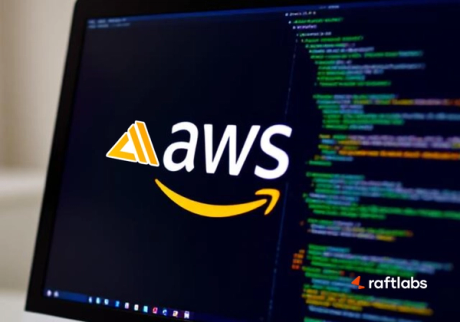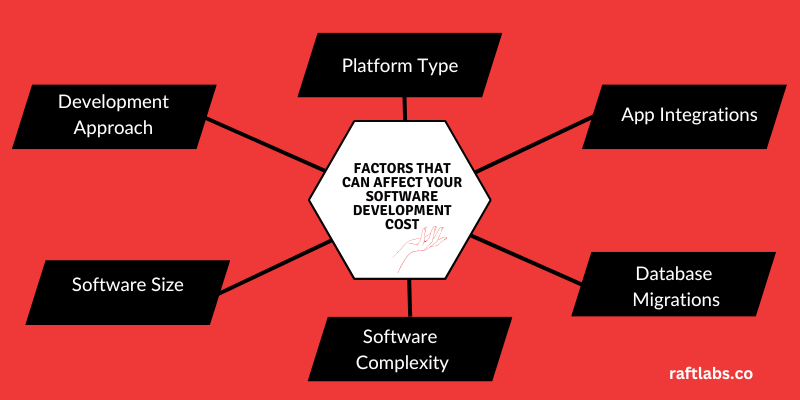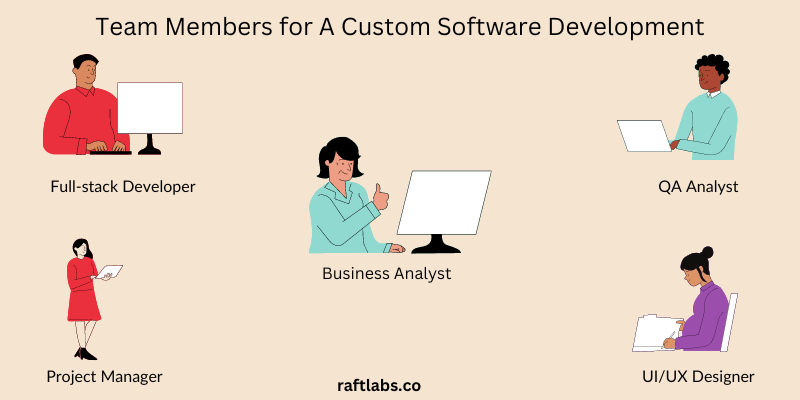
Custom Software Development Cost 2025 Complete Guide
- Riya Thambiraj
![Riya Thambiraj]()
- Web Development
- Last updated on
Thinking about building custom software for your business, but not sure how much it’ll cost? Then this guide will help you.
Custom software is an investment. Whether you're a startup or an established business, budgeting accurately can make or break your project.
In this guide, we’ll break down the key cost factors, pricing models, examples, and tips to help you make informed decisions.
You can achieve the following benefits with the right software solution:
Meet the business's exact needs.
Obtain higher efficiency.
Integration with existing products is possible.
Highly secure.
Able to deliver good customer experience.
Developing custom software can be costly. As the features and other elements vary, it is impossible to provide a fixed price.
What is Custom Software Development?
Custom software development is the process of designing, building, and maintaining software tailored specifically to your business needs.
Custom software is built from the ground up to fit your unique workflows, integrate with your existing systems, and solve your specific challenges.
Businesses usually use them when they are required to
Off-the-shelf products don’t meet their requirements.
They need to automate unique processes.
They want to gain a competitive edge with proprietary technology.
Fulfill specific requirements.
Provide a personalized experience to users.
Experts expect the global market size of custom software development to expand at a compound annual growth rate (CAGR) of 22.3% from 2022 to 2030.
Average Cost of Custom Software Development
The cost will vary based on the complexity of the project, like basic, medium, and advanced software, with other factors as per custom requirements.
Here’s a table to give you an overview of the average cost range of what different projects might cost:
| Project Type | Average Cost Range | Example Use Case |
|---|---|---|
| Minimum Viable Product (MVP) | $10,000 to $25,000 | Test a new app idea with core features |
| Custom Web Application | $10,000 to $50,000 | Internal business tools |
| SaaS Product | $20,000 to $200,000 | Subscription-based web software |
| Content Management System (CMS) | $20,000 to $250,000 | Custom website management |
| Customer Relationship Management (CRM) | $25,000 to $450,000 | Manage leads, sales, and customers |
| Marketplace | $10,000 to $300,000 | Buyer/seller platforms (e.g., eBay clone) |
| Learning Management System (LMS) | $10,000 to $250,000 | Online courses, student tracking |
| Mobile App | $10,000 to $200,000 | iOS/Android apps for customers/employees |
| Enterprise Resource Planning (ERP) | $40,000 to $400,000 | Manage resources, inventory, HR, and finance |
Cost Breakdown by Development Stage
Understanding where your money goes helps you plan better:
| Stage | What Happens Here? | % of Total Cost |
|---|---|---|
| Planning & Analysis | Define requirements, research, and scoping | 5–10% |
| Design | UI/UX design, wireframes, prototyping | 10–15% |
| Development | Coding, building features, and integrations | 50–60% |
| Testing & QA | Finding and fixing bugs, and security checks | 15–20% |
| Launch & Deployment | Go live, initial support | 5–10% |
| Maintenance | Ongoing support, updates (annual) | 10–20% |
Key Factors That Can Affect Your Software Development Cost

Factors that affect custom software development cost
1. Platform Type
Do you want to develop software for web or mobile app or both Android or iOS?
Or sometimes it could also be building software app desktop apps on Windows or Mac.
The software development cost may change depending on the platform you choose.
Let us see some of the platforms that businesses deploy custom software:
Unix
Linux
Windows
Mac
Android
iOS
Web.
Choose cross-platform development if you plan to deploy your software on multiple platforms. It often allows you to reuse the code and build the software in less time.
Hence, the software development costs will be less than building code in separate native environments.
2. Project or Software Size
Small Projects
Small software projects are great for businesses that are just starting. These projects focus on building simple and basic versions of a product so companies can test their ideas quickly. Examples include basic web or mobile apps.
Small projects are perfect for companies with a limited budget. They help get a working product up and running fast while leaving room to grow later.
Ideal For: Startups and small businesses
Cost: $20,000 – $50,000
Timeline: A few weeks to a few months
Software types: MVPs, Custom CRMs, Inventory Tools, Task Management Apps, Appointment Booking Systems
Mid-Range Projects
Mid-range projects are for companies that need more advanced features or want to combine multiple systems into one. These solutions help businesses manage more tasks and users as they grow.
These projects cost more and take longer because they need bigger teams and more planning.
Ideal For: Growing businesses looking to scale
Cost: $50,000 – $200,000
Timeline: Around 4 to 6 months
Software types: Advanced eCommerce sites, custom CMS, SaaS platforms, mobile & web apps, workforce tools, ERP systems.
Large-Scale Projects
Large-scale projects are built for big companies or enterprises that need strong, secure systems to handle a lot of users and data.
These solutions bring together different parts of a business, like accounting, HR, and operations, into one platform.
These projects take a long time and require expert teams with skills in data, security, and system management.
Ideal for: Enterprises and large organizations
Cost: Starts at $200,000 and can go much higher
Timeline: 12 to 24 months
Examples: ERP systems, banking software, AI/ML platforms, healthcare systems, cloud platforms, supply chain tools
The bigger the size of your software, the higher the costs.
It would be advisable to go for MVP development first. Once you are happy with the MVP, you can develop the complete version.
It will help you invest in the optimum app development budget and get the proper result.
3. Development Approach
Check whether the software development team follows the Agile process.
Agile projects have a 64% success rate, while waterfall projects have a lower success rate of 49%.
Agile Process:

The process emphasizes flexibility, collaboration, and continuous iteration and improvement.
Agile teams work in short, iterative cycles called "sprints" by dividing the project into smaller tasks.
They are easily adaptable and highly responsive to business needs and market conditions.
They follow a cost-effective development lifecycle.
The advantages of the agile process are:
- You can create a roadmap in the starting stage and get clarity about different aspects of the project.
- The software development team will develop prototypes that help in determining whether the product is right for you.
- Iterative sprints ensure minimal bugs, and the project doesn’t take longer development time.
4. Software Complexity
The more complex your software requirements, the higher the development cost. Simple software with basic functions is cheaper to build.
But if you want advanced features like AI, real-time analytics, or custom APIs, the development will take more time.
These capabilities often require experienced developers proficient in cutting-edge technologies, which naturally leads to higher costs.
So, reducing the complexity of your project can be a great way to reduce the price of your custom software development.
5. Design and User Experience (UI/UX)
A great design and smooth user experience make your software easier and more enjoyable to use, but they require extra effort.
If your software needs custom interfaces, animations, or a strong focus on user behavior, the cost becomes higher.
Simple interfaces are faster to build but may not provide the same impact. Investing in UI/UX design can mean higher upfront costs, but it often leads to happier users and better results for your business, Some of them are as below
Design and prototyping can affect the cost depending on the number of screens and features.
User testing and iteration and creating design assets such as icons and graphics will add to the final price.
Ongoing maintenance and design modifications can also increase the overall cost.
6. Third-Party Integrations
Integrating external systems such as payment gateways, CRMs, or marketing tools adds functionality but also increases development time and complexity.
That means your app may need integrations with the following:
Third-party app integrations
APIs
Enterprise legacy apps.
Integration with legacy applications may cost more while building software. Likewise, building new APIs can also result in a rise in development costs.
So, seamless app integration requires careful planning and testing, which can significantly impact the budget.
Reducing the complexity of your project can be a great way to reduce the price of your custom software development.
7. Team Expertise and Location
The skills and experience of your development team play a big role in your project’s cost. Teams with deep technical experience may charge more but bring better results.
Where your team is based also matters. Developers in the US or Western Europe typically have higher rates, while teams in India, Eastern Europe, Asia, or Latin America can offer quality work at lower prices.
RaftLabs is a trusted choice for custom software development. With over 9 years of experience, our company is committed to delivering high-quality, affordable solutions tailored to your business needs.
8. Database Migrations
Moving data from existing systems to new software is often more complex than it appears, especially if your project involves legacy integrations or inconsistent data formats.
It involves data extraction, cleaning, transformation, and secure import into the new platform.
Proper planning and execution are essential to avoid data loss and ensure a smooth transition.
A more extensive database will have higher security requirements and existing potential vulnerabilities. These elements will increase the cost of custom software development.
An experienced software development team can help to complete the phase more smoothly.
9. Project Timeline
How fast you need the software completed will influence the cost. If you have a tight deadline, your development team may need to work overtime or bring in extra people, which increases expenses.
If your timeline is flexible, development can be paced more efficiently and cost-effectively.
Building an MVP will take less time; thus, you can find the right product for your business within less time.
If you plan to build an MVP first, you will be able to test the quality of your product soon.
The shorter the development period, the lower the costs you will incur.
Always begin from the product discovery phase and reduce the project risks early. It will help you spend the optimum budget for your custom software project.
10. Who’s Making Your Software
The type of partner you choose, whether it’s an established agency, a group of freelancers, or your in-house team, will impact both the price and the process.
Agencies usually charge more but offer full support, project management, and proven workflows. Whereas freelancers might be more budget-friendly, you’ll need to coordinate and manage the project more closely.
Building an in-house team gives you full control but comes with hiring and training costs, and the budget will become higher.
So, choosing a specialized product team like RaftLabs can be more flexible both in budget as well as product completion as per the custom requirements.
11. Team Salary
The cost of team pay may vary depending on the skill level and experience of the members you hire.
Wages for highly trained and experienced software developers will be higher.
The app development team size can also reflect the total cost of team wages. A larger team will usually have more compensation than a smaller one.
The app development team's location can also affect the cost of team wages. For example, wages in significant cities or tech clusters may be higher than in other regions.
First, let us see the team members required for your custom software development:

Team members required for a custom software development
Full-stack Developer: They are in charge of the complete development process, from initial concept and design to coding, testing, and software deployment.
Project Manager: The project manager manages the project team, defines timetables, and ensures that all tasks proceed per the project plan.
Business Analyst: The business analyst identifies stakeholders' business needs, collects and assesses requirements, and presents those requirements to the software development team.
QA Analyst: The QA analyst guarantees that the software satisfies the customer's demands and ensures the product delivers high-quality output.
UI/UX Designer: UI/UX designers are responsible for creating the best appearance and feel of the software and the user experience. They prepare wireframes, mockups, and prototypes to test the software's usability.
Engagement Models for Outsourcing Custom Software Development
You will need to partner with a software vendor to build your custom software.
You can mainly follow the below two engagement models:
IT staff augmentation
Does your company already have an inshore IT team?
Do you need to strengthen the team further to develop the custom software?
As per this model, you can hire as many team members to meet your requirements.
Features:
Increase the overall capacity or expertise of its IT department.
Get experienced professionals who have specialized knowledge and skills.
A cost-effective way to meet business objectives.
Product Development
Do you have an idea for a solution for building software for your dream project?
This model is the best option if you are looking for a development partner to develop your idea.
Features:
Start building the software from scratch.
The developer will be responsible for creating your product.
The price depends on the agreement with your partner.
Custom Software Development Costs in Different Regions
The cost to develop custom software for your business can vary depending on the location of the software development team.
To get a rough idea, let us see each region's average price per hour for software development.
North America (USA, Canada)
North America offers some of the highest-quality and most experienced software development teams, but you can expect to pay premium rates for their services.
Rates typically range from $100 to $200 per hour. You’ll find experienced teams with strong technical skills, but this is one of the most expensive regions for software development.
Western Europe (UK, Germany, France)
Western Europe is also known for high-quality standards and strict compliance, but you’ll see higher hourly rates.
Hourly rates fall between $80 and $150. Developers here offer solid expertise and business communication, but costs remain relatively high compared to other regions.
Eastern Europe (Poland, Ukraine, Romania)
Eastern Europe provides a balance of strong technical expertise and competitive pricing.
Hourly rates for developers generally fall between $40 and $80, making these regions attractive for businesses seeking quality at a moderate cost.
Asia (India, Vietnam, Philippines)
South Asia, including countries like India and Bangladesh, is known for its vast talent pool and cost-effective solutions.
Hourly rates here typically range from $20 to $50 per hour, making it a go-to region for startups and businesses looking for affordability and scalability.
Latin America (Brazil, Argentina, Colombia)
Latin America is gaining popularity for nearshore outsourcing, making this region attractive for US-based businesses looking for time zone alignment and lower costs.
You’ll find hourly rates between $27 and $65, which can help optimize your budget without compromising on communication or collaboration.
Africa (Nigeria, Kenya, South Africa, etc.)
Africa’s tech ecosystem is growing quickly, with skilled developers emerging across the continent at competitive prices.
Hourly rates typically range between $25 and $50, making it an attractive option for businesses seeking lower prices.
So, when choosing a region, consider not just the hourly rates but also factors like time zone alignment, communication styles, and the complexity of your project.
At RaftLabs, we help you weigh these variables and ensure your investment in custom software delivers the best possible value for your business.
6. Simple Tips to Reduce the Custom Software Development Costs

Tips to reduce the cost of custom software development
The below tips will help you reduce the overall budget of custom software development without compromising the quality.
Understand the project requirements clearly.
Find a reliable software development company that provides experienced engineers.
Communicate well with the software development team.
Proper planning regarding the project timelines.
Perform software testing which is an integral part of software development.
Prioritize the necessary features.
7. Estimate Your Custom Software Development Cost
Now you know the cost-determining factors of custom software development. It’s time to learn an estimated cost for your custom software project.
Type, No.of Features, Characteristics, Development Time, Estimate Cost
Simple Custom Application
4-5
minimal content
less interactive elements
simple UI/UX design.6-8 weeks
US$ 10-25K
Medium Custom Application
6-9
more content
fewer interactive elements
3rd party integrations3-4 months
US$ 25-50K
Complex Custom Application
10-15
high performance
feature-rich
conversion-driven design3-5 months
start from US$ 50K
8. Request for Proposal
A Request for Proposal (RFP) is a document requesting proposals from potential vendors for custom software development projects. A typical request for a proposal must have the following information:
Project scope and deliverables
Desired features and functionality
List of experts you seek
Deadlines, etc.
Criteria to evaluate the proposal, etc.
The document allows a potential vendor to give an accurate estimate of the budget you will require to complete the project.
Conclusion
Basic projects often cost a few thousand dollars, whereas massive, sophisticated projects require a considerable budget. Before beginning a custom software development project, firms should carefully examine their needs and budgets and work closely with a credible development team to ensure the project's success.
Outsourcing can be a great option for creating a custom application. You don't have to worry about providing employee benefits, covering infrastructure costs, or other IT costs.
At RaftLabs, we have a team of experts who can build custom software solutions aligning with a client's needs. We communicate the requirements and budget with each client before proceeding further with the project. We also provide suggestions to help you reduce software development costs and get the best results.
Contact us if you wish to have a free technical discussion with our team to build custom software solutions.


